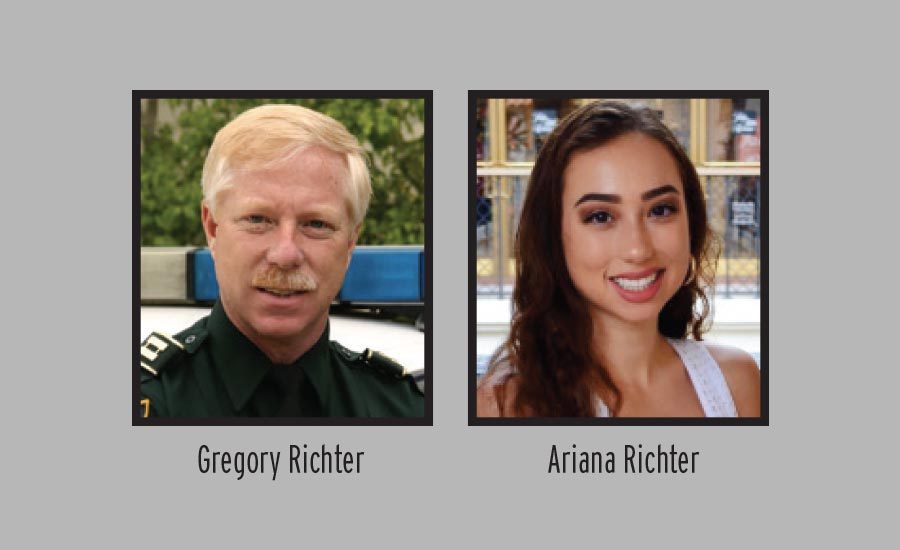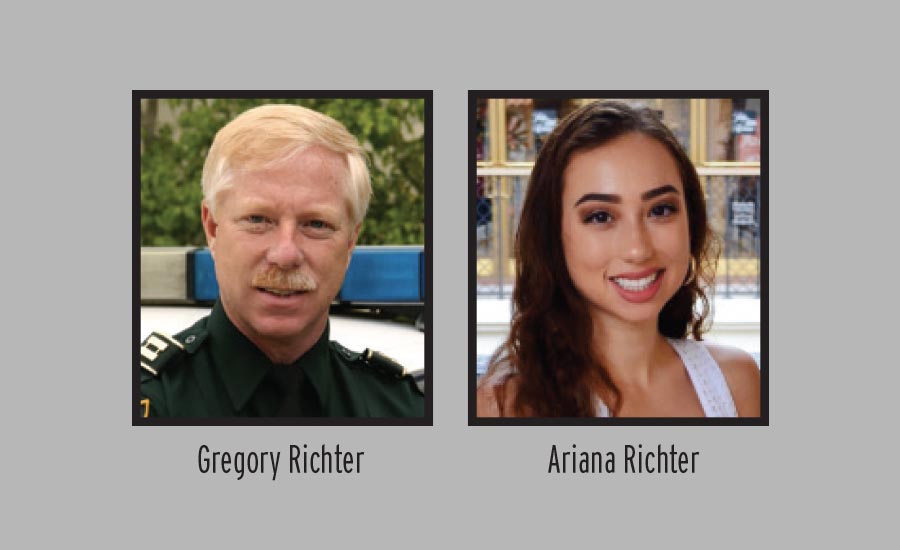The Incel Killer and the Threat to the Campus Community
The “Incel” killer seems to have surfaced as the latest hidden, yet extremely dangerous, threat to society and the campus community.


About the Authors
Gregory Richter is the Director of Safety and Security at Keiser University in Ft. Lauderdale, Fla. He has a Master of Science in Criminal Justice. He is a retired captain with 35 years of law enforcement experience and is an adjunct faculty member of Criminal Justice. Ariana Richter is a student at Florida State University in Tallahassee, Florida, majoring in International Studies. She is a member of the Pi Beta Phi sorority.


On November 2, 2018, Scott Beierle, an often unemployed, 40 year-old army veteran who holds two masters degrees, walked into a Tallahassee Hot Yoga studio, located just minutes from Florida State University, and opened fire, killing two females before turning the gun on himself.
Beierle was found dead at the scene, along with his victims, Maura Binkley, a 21 year-old Florida State University student, and Dr. Nancy Van Vessem, a 61 year-old Florida State University professor.
Unlike most crimes of this nature, there was no evidence of a “robbery gone bad” nor was there a domestic relationship between any of the parties. What soon was discovered was something even more sinister: the killer was a self-described Involuntary Celibate or “Incel,” with a seething rage against women.
The Involuntary Celibate or “Incel” killer seems to have surfaced as the latest hidden, yet extremely dangerous, threat to society and the campus community. Fueled and supported by online forums on the “dark web,” the Incel is characterized by resentment, misanthropy, self-pity, self-loathing, misogyny, racism, a sense of entitlement to sex and the endorsement of violence against sexually active people. This hatred is particularly directed at “Stacys” (the name given by Incels to attractive women) and “Chads” (the men that are intimate with them). Most Incels are white, male and heterosexual. Although not a formally recognized mental or pshychological disorder, the online Incel community has self identified with this term since 1993. The reasons for identifing as an Incel can be as varied as each individual, but what most Incels do seem to have in common is a hatred for others, especially women, assigning blame to everyone but themselves and the belief that those that they perceive reject them deserve to be punished. The Southern Poverty Law Center has described the Incel subculture as “part of the online male supremacist ecosystem” that is included in their list of hate groups.
Like many other Incels, Scott Beierle displayed a history of anti-social behaviors. He had been arrested three times by the Florida State University police and was banned from the FSU campus after he followed a female volleyball coach into a gym. Beierle openly shared his contempt for people online, posting videos calling women negative names, and in one video titled “The Rebirth of My Misogynism,” he stated that his hatred for women started in the eighth grade. His online posts recounted a string of instances that made him feel personally rejected by females. His hatred was not just reserved for women; he also posted about his hatred for cops, interracial dating and African Americans.
Perhaps the most alarming part of this entire story is that Beierle is not alone in his level of hatred, and even worse, his actions. Since 2014, at least four other mass shootings have been attributed to individuals identifying as an Incel, or those sympathizing with the movement:
May 23, 2014. Elliot Rodger killed six people and injured 14 others before killing himself at Isla Vista, Calif., near the campus of University of California, Santa Barbara. Rodger blamed the killings on his inability to get women to date him. He described himself as “the perfect guy, the supreme gentleman,” and left behind a 137-page manifesto along with YouTube videos detailing his involuntary celibacy and discussing his revenge for being rejected by women.
October 1, 2015. Chris Harper Mercer killed nine people and injured eight others before killing himself in a shooting at the Umpqua Community College campus in Roseburg, Ore. He left a manifesto at the scene detailing his interest in other mass murders, including Elliot Rodger, his anger at not having a girlfriend and his overall anger at the world.
December 7, 2017. William Atchison killed two people before killing himself at Aztec High School in Aztec N.M. Atchison, a former student of Aztec High School had used the pseudonym “Elliot Rodger” on several online forums and praised the “supreme gentleman” (Elliot Rodger).
February 14, 2018. Nikolas Cruz killed 17 people and injured 17 others in a shooting at Stoneman Douglas High School in Parkland, Fla. before being arrested. Cruz had previously posted online that “Elliot Rodger will not be forgotten.”
As campus safety professionals, how can we keep our campuses as safe as possible, even against such violence and hatred?
Most campuses are open institutions – large sprawling environments with walkways, roadways, restaurants, offices and buildings where people can freely drive and walk about the campus unnoticed and unchallenged. These campus environments allow most individivuals easy access and freedom of movement. Even campuses that are more restrictive can still be vulnerable because there is no guarantee that the Incel will not be a person that is authorized to be on campus, such as a student or staff member. In terms of the Incel, campus safety professionals must rely on proven active shooter/armed aggressor response protocols and, just as importantly, should attempt to identify the potential aggressor’s warning signs before he strikes. It is further recommended that the campus community follow a safety plan that includes Incel recognition, prevention techniques and response protocols.
Recognition
The first important step of the safety plan is recognizing that Incels do exist in our society and remaining vigilant for individuals that leave clues about their potential threats or actions. For example, when looking deeper into the lives of the five aggressors described here, prior to committing the killings almost all of them had previously expressed a hatred and desire to do harm to others.
One of the ways to educate campus staff about Incel recognition is to include this issue as supplemental information to current campus active shooter/armed aggressor training. This training should describe Incels, what motivates them and how their resentment and hatred for women and others is characterized in their speech, online posts and their actions. Training should also include a discussion about how Incels communicate on the “dark web.”
Important to note is that the social web platforms used by Incels often change because they are continuously banned, so they move on to other social platforms. A web search can quickly reveal the active Incel social platforms along with the jargon used by the Incel community (such as “Stacy and Chad,” “ER” (Elliot Rodger), and the “Black Pill” (realization that one is an Incel). This information should be presented by a subject matter expert, so staff can be alert for this type of aggressor and their common behavioral clues.
Prevention
Although potential threats are not always brought to the attention of law enforcement or other campus authorities, in many instances “someone” did know. Whether the person that knows about the threatening behavior is a friend, classmate or family member, it is important that the campus community stresses the “see something, hear something, say something” rule, and ALL reports must be followed up by campus security, campus administration and/or law enforcement. To illustrate this point, one need only read the media accounts and community outcry when it was discovered that Nicholas Cruz was reported to authorities 18 times, yet still was able to commit his violent act and killings.
Universities may not have the resources to monitor students’ and employees’ social media; however, when threatening or violent posts are brought to the attention of campus administration, this should be immediately reported to authorities. If individuals post comments of a threatening nature on another person’s social media, or on the school social news or message boards, this should be reported and thoroughly investigated.
Although not an automatic indicator, previous violent attackers have often exhibited escalating behaviors such as hate speech, verbalizing violent fantasies, or verbal or written threats, prior to committing actual physical violence. It is possible that the Incel may even “self-report” in one of these ways to intimidate or threaten others, or possibly as a cry for help. It is important to note that not all individuals that identify as an Incel are necessarily violent, however, it is always best to err on the side of caution and treat every threat as an actual threat, and immediately notify security and/or law enforcement. Most law enforcement agencies have contacts with mental health services to refer individuals that do not rise to the level of arrest but may pose a potential threat to themselves or others.
Response
Finally, should the unthinkable occur and the Incel does appear on campus to do harm, ALL staff, faculty and students must be trained in active shooter/armed aggressor response to mitigate the threat and save as many lives as possible. The Department of Homeland Security’s “Run, Hide and Fight” active shooter response protocols and informative video is a fast and highly informative program that can be easily presented to all members of the campus community. This information should also be made available on the campus safety and security website.
By recognizing the threat of the Incel, focusing on common sense prevention techniques and practicing proven response protocols, the campus community can help minimize the risk.
Looking for a reprint of this article?
From high-res PDFs to custom plaques, order your copy today!








